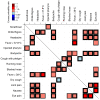Respiratory viral pathogens among Singapore military servicemen 2009-2012: epidemiology and clinical characteristics
- PMID: 24735158
- PMCID: PMC4006965
- DOI: 10.1186/1471-2334-14-204
Respiratory viral pathogens among Singapore military servicemen 2009-2012: epidemiology and clinical characteristics
Abstract
Background: Few studies have comprehensively described tropical respiratory disease surveillance in military populations. There is also a lack of studies comparing clinical characteristics of the non-influenza pathogens with influenza and amongst themselves.
Methods: From May 2009 through October 2012, 7733 consenting cases of febrile respiratory illness (FRI) (temperature [greater than or equal to]37.5 degrees C with cough or sorethroat) and controls in the Singapore military had clinical data and nasal washes collected prospectively. Nasal washes underwent multiplex PCR, and the analysis was limited to viral mono-infections.
Results: 49% of cases tested positive for at least one virus, of whom 10% had multiple infections. 53% of the FRI cases fulfilled the definition of influenza-like illness (ILI), of whom 52% were positive for at least one virus. The most frequent etiologies for mono-infections among FRI cases were Influenza A(H1N1)pdm09 (13%), Influenza B (13%) and coxsackevirus (9%). The sensitivity, specificity, positive predictive value and negative predictive value of ILI for influenza among FRI cases were 72%, 48%, 40% and 69% respectively. On logistic regression, there were marked differences in the prevalence of different symptoms and signs between viruses with fever more prevalent amongst influenza and adenovirus infections than other viruses.
Conclusion: There are multiple viral etiologies for FRI and ILI with differing clinical symptoms in the Singapore military. Influenza and coxsackevirus were the most common etiology for FRI, while influenza and adenoviruses displayed the most febrile symptoms. Further studies should explore these differences and possible interventions.
Figures



References
Publication types
MeSH terms
Substances
LinkOut - more resources
Full Text Sources
Other Literature Sources
Medical

